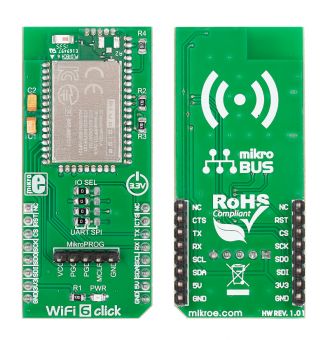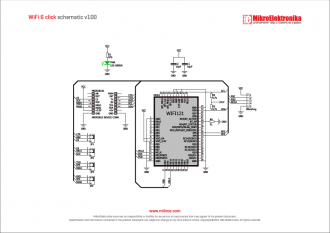
We strongly encourage users to use Package manager for sharing their code on Libstock website, because it boosts your efficiency and leaves the end user with no room for error. [more info]

Rating:
Author: MIKROE
Last Updated: 2016-10-25
Package Version: 1.0.0.0
Category: WIFI
Downloaded: 554 times
Not followed.
License: MIT license
WiFi 6 click is a mikroBUS add-on board whose functionality is determined by two components: a WF121-A Wi-Fi module for communication over 2.4GHz band with excellent performance, and a PIC32MX695H MCU for end user applications to be embedded onto the click board itself.
Do you want to subscribe in order to receive notifications regarding "WiFi 6 click library" changes.
Do you want to unsubscribe in order to stop receiving notifications regarding "WiFi 6 click library" changes.
Do you want to report abuse regarding "WiFi 6 click library".
| DOWNLOAD LINK | RELATED COMPILER | CONTAINS |
|---|---|---|
| 1474018171_wifi_6_click_lib_mikroc_arm.zip [707.99KB] | mikroC PRO for ARM |
|

WiFi 6 click is a mikroBUS add-on board with Bluegiga's WF121-A self-contained Wi-Fi module. With a fully integrated radio and 32-bit microcontroller, this module is ideal for embedded applications.
The module's 2.4GHz band radio is fully compliant with IEEE 802.11b/g/n and offers excellent radio performance.Allows end user applications to be embedded onto the integrated PIC32MX695H, a 32-bit 80MHz microcontroller with 128KB RAM and 512KB Flash memory, for development of lower-cost and smaller sized products. Also integrated on-board is a single power supply.
WiFi 6 click communicates with the target MCU through the mikroBUS UART (TX, RX), SPI, or IC2, with additional functionality provided by CTS pin (in place of default mikroBUS™ INT pin); a mikroProg connector allows to update the firmware of the internal PIC32. SPI interface can be accessed by jumpers on the click board. The board is designed to use a 3.3 power supply only.
